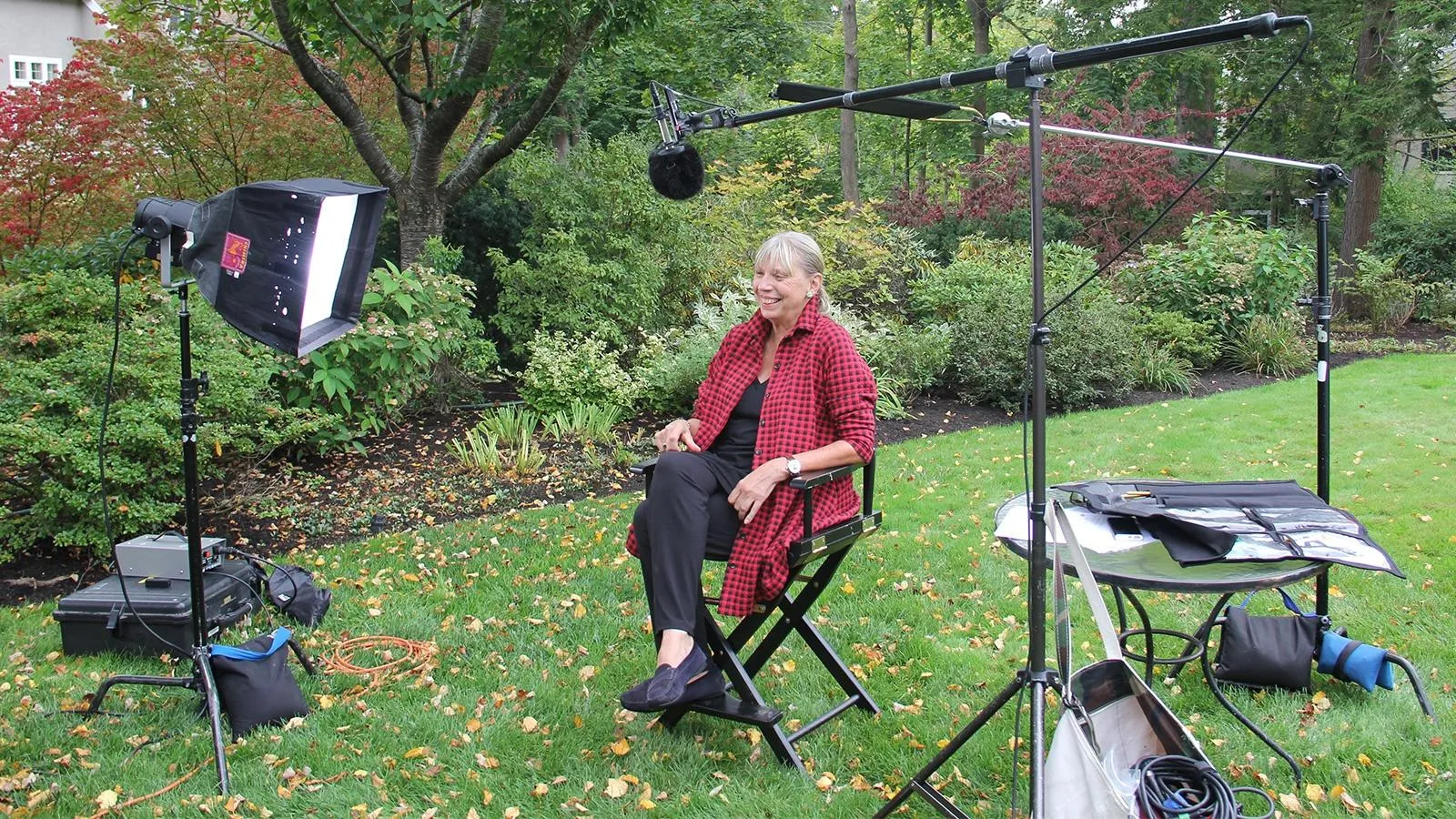Arlie Sulka - Tiffany Studios Vases & Crates
APPRAISER: This is a Tiffany lava…
HOST: From puppetry arts to decorative arts. Now the story of how longtime Tiffany expert Arlie Sulka finally found her Holy Grail at a rainy ROADSHOW in Newport, Rhode Island, in 2017.
APPRAISER: In Newport, we had the threat of a hurricane and it was our first outdoor venue. But the show did go on. This lady was pulling this cart with a crate, it was a bit unwieldy, and she pulled out a piece of glass from the crate and put it on the table, and my heart practically stopped, because I had been waiting for that piece of glass for almost 20 years. I ran over to the volunteer, who had to radio the producer, and I said, "Whoever you're calling, please tell that producer that Arlie has found the Holy Grail." This is the greatest piece of glass that I was ever gonna see on ANTIQUES ROADSHOW.
GUEST: During the Depression, my aunt started buying up these vases from Tiffany's. So I guess she ordered some by the crateload.
APPRAISER: On the side, it actually says "Louis C. Tiffany Studios." It's not often that people keep the shipping crates. So let's talk about what you have. The first piece of glass, which is what we would call pastel glass...
GUEST: Mm-hmm.
APPRAISER: ...is later-production Tiffany.
GUEST: Okay.
APPRAISER: It was made in the '20s, it was made in multiples, and it came in different colors. Usually when you see pastel glass, um, that Tiffany made, they're mostly utilitarian pieces-- it's serviceware. This was a little more of a standout piece because it's an art glass vase. That vase was not meant to ever have water or flowers in it. The flowers are actually in the vase already, so it was the best of its kind, but it wasn't as good as the other two pieces. Now, this piece is a paperweight glass vase.
GUEST: Mm-hmm.
APPRAISER: Leslie Nash, who worked for Louis Comfort Tiffany, claims that while they were working with paperweight glass, Louis Tiffany himself, who was a painter, came into the glassworking shop, handed them a painting of morning glories that he had painted and said...
GUEST: Ah...
APPRAISER: "I want you to make this in glass."
GUEST: Wow.
APPRAISER: 1914 is when they first introduced it. Your piece, on the bottom, says "exhibition piece" on it. And I know from the date letter on it, which is a suffix L, that that would be somewhere around 1915. So it's possible that this could have gone to the 1915 San Francisco International Exhibition.
GUEST: Okay.
APPRAISER: Most major museums would like or already have a morning glory paperweight in their collections. A morning glory is something that Tiffany collectors aspire to have in their collection. Tiffany was very proud of it, and this was an exceptionally lovely piece. So, just to give you an idea of value, the, the crate, in a retail setting-- this is something for Tiffany geeks everywhere, collectors, museums-- they would actually be very excited about this, and it would be worth between $5,000 and $10,000.
GUEST: Holy cow!
APPRAISER: This piece, which is not as sought-after as some of the other art glass...
GUEST: Mm-hmm.
APPRAISER: ...would retail in probably between $2,000 and $3,000.
GUEST: Uh-huh.
APPRAISER: But this piece, in a retail shop, it could be sold for anywhere between $50,000 and $75,000.
GUEST: No way! Oh, my gosh! I was... thinking maybe, $8,000 to $10,000, I was hoping-- wow.
APPRAISER: Well, that was a long time ago.
GUEST: Wow, I, I really didn't know what the market had done. You know, if it had gone sideways or up or down, but wow. (inhales through teeth)
APPRAISER: So there's one other thing in here that I want to talk about. This vase. This practically stopped my heart... (chuckles) ...when I saw it in the box. This is the piece I was waiting for for 20 years.
GUEST: Oh, wow!
APPRAISER: And what I can tell you is, every night before the ROADSHOW, people would always say, "What is on your wish list? What would you like to come into the show tomorrow?" And I always say, "A Tiffany lava vase."
GUEST: Wow.
APPRAISER: And that's what this is. It's extremely special. It is meant to look like molten lava on the surface of the vase.
GUEST: Mm-hmm.
APPRAISER: And this one is particularly interesting, because you also have these protrusions here. And it's very similar to a vase that was shown in the 1906 Paris Salon Exhibition.
GUEST: Oh...
APPRAISER: The thing about lava is, it was very hard to make. They get cracked in the making.
GUEST: Oh.
APPRAISER: And I did go over your lava with my special light and a magnifying glass, and I couldn't find any imperfections.
APPRAISER: Lava glass evolved out of a different type of glass that Tiffany first started to make in the late 1890s. That was called Cypriot glass. And the Cypriot glass was made to imitate the excavated glass that was found on Cyprus in the late 19th century by Luigi Palma di Cesnola, who gave all of what he found to the Metropolitan Museum. And we know that Tiffany saw that glass and it did inspire him to reproduce what nature had done to the glass in the studios. This was a very difficult, multilayered process. It's not what you normally see or what you expect to see with Tiffany. Most people identify immediately with the gold and the blue iridescent pieces of glass. Those are the most widely recognized. When you get into the more extreme art glass, uh, this is the top rung.
APPRAISER: An example like this in a retail shop could sell between $100,000 and
$150,000.
GUEST: (laughing) Where's my brother? He's gonna... (laughs) Wow, that's unbelievable. I had no idea.
APPRAISER: Two years after Newport, in the fall of 2019, Susan and her siblings contacted me and said they were ready to part with the pieces. And they said, "And do you want the crate?" And I said, "Of course I want the crate!" So they drove down to New York and they brought me their three pieces and the crate. What I did was, I bought the pastel vase and I bought the crate. I actually didn't buy the morning glory, because, um, Sue said it was just very sentimental because her aunt had given it to her when she graduated either from high school or from college, and so she really wasn't ready to let it go. But I don't think she was particularly interested in keeping the lava vase. I always tell people they, collectors, you should buy what you like. And in this case, I don't think that she liked that piece all that much. It wasn't getting any more beautiful even though she found out that it had great value. I made an arrangement on the lava piece that I felt that I could place it in a private collection, which I did shortly thereafter. I sold it on their behalf and placed it in that collection. As a dealer, a transaction between a, a buyer and a seller is kept confidential. It's not like an auction where all the results are publicly noted. So while I can't reveal what was paid for the piece, I can say that the, the buyer, the seller, and the in-between person were very pleased.

$157,000 - $238,000 Retail
Featured In

episode
Extraordinary Finds 2
Learn what happens to more standout treasures after the ROADSHOW cameras stop rolling!
Understanding Our Appraisals
Placeholder


